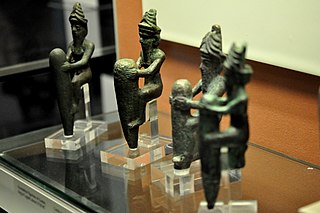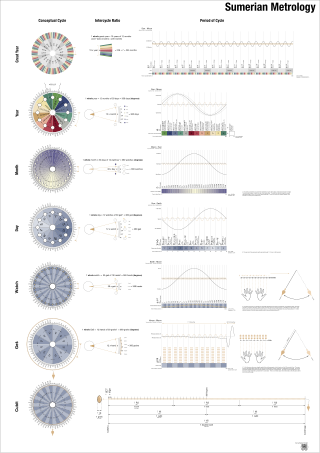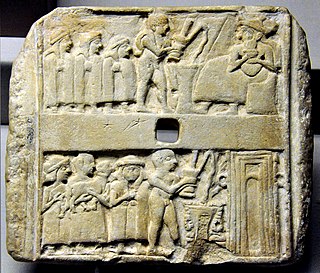Akkadian literature is the ancient literature written in the Akkadian language in Mesopotamia during the period spanning the Middle Bronze Age to the Iron Age.

Nergal was a Mesopotamian god worshiped through all periods of Mesopotamian history, from Early Dynastic to Neo-Babylonian times, with a few attestations indicating that his cult survived into the period of Achaemenid domination. He was primarily associated with war, death, and disease, and has been described as the "god of inflicted death". He reigned over Kur, the Mesopotamian underworld, depending on the myth either on behalf of his parents Enlil and Ninlil, or in later periods as a result of his marriage with the goddess Ereshkigal. Originally either Mammitum, a goddess possibly connected to frost, or Laṣ, sometimes assumed to be a minor medicine goddess, were regarded as his wife, though other traditions existed, too.

Marduk was a god from ancient Mesopotamia and patron deity of the city of Babylon who eventually rose to power in the First Millennium BCE. In the city of Babylon, Marduk was worshipped in the temple Esagila. His symbol is the spade and he is associated with the Mušḫuššu.
Zecharia Sitchin was an author of a number of books proposing an explanation for human origins involving ancient astronauts. Sitchin attributed the creation of the ancient Sumerian culture to the Anunnaki, which he stated was a race of extraterrestrials from a planet beyond Neptune called Nibiru. He asserted that Sumerian mythology suggests that this hypothetical planet of Nibiru is in an elongated, 3,600-year-long elliptical orbit around the Sun. Sitchin's books have sold millions of copies worldwide and have been translated into more than 25 languages.

The Anunnaki are a group of deities of the ancient Sumerians, Akkadians, Assyrians and Babylonians. In the earliest Sumerian writings about them, which come from the Post-Akkadian period, the Anunnaki are deities in the pantheon, descendants of An and Ki, the god of the heavens and the goddess of earth, and their primary function was to decree the fates of humanity. They should not be confused with the Apkallu.

Enūma Eliš is the Babylonian creation myth. It was recovered by English archaeologist Austen Henry Layard in 1849 in the ruined Library of Ashurbanipal at Nineveh. A form of the myth was first published by English Assyriologist George Smith in 1876; active research and further excavations led to near completion of the texts and improved translation.

The Babylonian calendar was a lunisolar calendar used in Mesopotamia from around the second millennium BCE until the Seleucid Era, and it was specifically used in Babylon from the Old Babylonian Period until the Seleucid Era. The civil lunisolar calendar was used contemporaneously with an administrative calendar of 360 days, with the latter used only in fiscal or astronomical contexts. The lunisolar calendar descends from an older Sumerian calendar used in the 4th and 3rd millennia BCE.

Nabu is the Babylonian patron god of literacy, the rational arts, scribes, and wisdom. He is associated with the classical planet Mercury in Babylonian astronomy.
Anshar was a Mesopotamian god regarded as a primordial king of the gods. He was not actively worshiped. He was regarded as the father of Anu. In the first millennium BCE his name came to be used as a logographic representation of the head god in the Assyrian state pantheon, Ashur. He is attested in a number of god lists, such as An = Anum, and in literary compositions, including the Enūma Eliš.

Babylonian religion is the religious practice of Babylonia. Babylonia's mythology was greatly influenced by its Sumerian counterparts and was written on clay tablets inscribed with the cuneiform script derived from Sumerian cuneiform. The myths were usually either written in Sumerian or Akkadian. Some Babylonian texts were translations into Akkadian from Sumerian of earlier texts, but the names of some deities were changed.

Babylonian astronomy was the study or recording of celestial objects during the early history of Mesopotamia.

Babylonian astrology was the first known organized system of astrology, arising in the second millennium BC.

MUL.APIN is the conventional title given to a Babylonian compendium that deals with many diverse aspects of Babylonian astronomy and astrology. It is in the tradition of earlier star catalogues, the so-called Three Stars Each lists, but represents an expanded version based on more accurate observation, likely compiled around 1000 BCE. The text lists the names of 66 stars and constellations and further gives a number of indications, such as rising, setting and culmination dates, that help to map out the basic structure of the Babylonian star map.
Gibil (𒀭𒉈𒄀), also known under the Akkadian name Girra, was a Mesopotamian god associated with fire, both in its positive and negative aspects. He also played a role in ritual purification. Textual sources indicate his symbol was a torch, though no representations of him have been identified in Mesopotamian art. Multiple genealogies could be assigned to him. The god list An = Anum indicates his spouse was Ninirigal. He was also frequently associated with deities such as Shamash, Nuska and Kusu. He is first attested in Early Dynastic texts from Shuruppak, such as offering lists. He was also a member of the pantheon of Eridu. In the Kassite period he was worshiped in Nippur. Later attestations are available from Assyria and from Uruk. He also appears in a number of literary texts.
Šulpae was a Mesopotamian god. Much about his role in Mesopotamian religion remains uncertain, though it is agreed he was an astral deity associated with the planet Jupiter and that he could be linked to specific diseases, especially bennu. He was regarded as the husband of Ninhursag. Among the deities considered to be their children were Ashgi, Panigingarra and Lisin. The oldest texts which mention him come from the Early Dynastic period, when he was worshiped in Kesh. He is also attested in documents from other cities, for example Nippur, Adab and Girsu. Multiple temples dedicated to him are mentioned in known sources, but their respective locations are unknown.

Babylonian astronomy collated earlier observations and divinations into sets of Babylonian star catalogues, during and after the Kassite rule over Babylonia. These star catalogues, written in cuneiform script, contained lists of constellations, individual stars, and planets. The constellations were probably collected from various other sources. The earliest catalogue, Three Stars Each, mentions stars of Akkad, of Amurru, of Elam and others. Various sources have theorized a Sumerian origin for these Babylonian constellations, but an Elamite origin has also been proposed. A connection to the star symbology of Kassite kudurru border stones has also been claimed, but whether such kudurrus really represented constellations and astronomical information aside from the use of the symbols remains unclear.

Anu or Anum, originally An, was the divine personification of the sky, king of the gods, and ancestor of many of the deities in ancient Mesopotamian religion. He was regarded as a source of both divine and human kingship, and opens the enumerations of deities in many Mesopotamian texts. At the same time, his role was largely passive, and he was not commonly worshipped. It is sometimes proposed that the Eanna temple located in Uruk originally belonged to him, rather than Inanna, but while he is well attested as one of its divine inhabitants, there is no evidence that the main deity of the temple ever changed, and Inanna was already associated with it in the earliest sources. After it declined, a new theological system developed in the same city under Seleucid rule, resulting in Anu being redefined as an active deity. As a result he was actively worshipped by inhabitants of the city in the final centuries of the history of ancient Mesopotamia.

Sumerian religion was the religion practiced by the people of Sumer, the first literate civilization of ancient Mesopotamia. The Sumerians regarded their divinities as responsible for all matters pertaining to the natural and social orders.
Wayne Horowitz is an archeologist and academic. He specialises in the ancient Near East and Assyriology.
Erragal or Errakal was a Mesopotamian god presumed to be related to Erra. However, there is no agreement about the nature of the connection between them in Assyriology. While Erragal might have been associated with storms and the destruction caused by them, he is chiefly attested as a benevolent deity, for example as an astral god with apotropaic functions. He was regarded as the husband of the goddess Ninšar, the divine butcher of Ekur, and they could be represented as a pair of stars in astronomical treatises such as MUL.APIN. References to worship of Erragal are uncommon, though he nonetheless appears in a variety of sources from the Isin-Larsa period to Neo-Babylonian times. He also appears in the Epic of Gilgamesh and in Atra-Hasis as a deity linked to the great flood.











